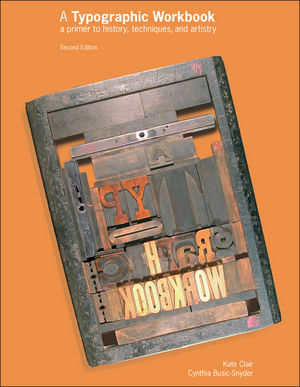A Typographic Workbook: A Primer to History, Techniques, and Artistry, 2nd EditionISBN: 978-0-471-69690-2
Paperback
400 pages
August 2005
 |
||||||
Preface v
Acknowledgments vi
1: Ancient Writing Systems 1
Prehistoric Societies; Development of Oral Communication; Early Writing Societies; Pictograph-Based Writing Systems; From Pictographs to Ideographs; The Semitic Languages; Sumerian Cuneiform; Minoan Writing; Written Languages Remain Undeciphered; Egyptian Hieroglyphics; Hieratic Script; Demotic Script; Ancient Writing Systems Evolve; The Rise of Ancient Greece; and Recovering Ancient Egyptian Hieroglyphics
2: Lettering During the Roman Empire and Middle Ages 23
Impact of the Roman Empire; Roman Triumphal Arches; Roman Lettering; Capitalis Quadrata to Rustica; Constantine Ends Christian Persecution; The Roman Empire Divided; The Scroll versus the Codex; Roman Script; Christianizing of Ireland and the Celtic Lettering; The Crumbling Empire Leads to Feudalism; Celtic Round Uncials; Lettering as a Declaration of Faith; A Unifying Force in Lettering; The Romanesque Hand Invites Innovation; The Development of the Gothic Textura Hand; Mediterranean Expansion of Muslims; Development of Rag Paper in Europe; The Late Gothic Period; Rotunda Compared to Gothic Lettering; and Setting the Stage for the Renaissance
3: Renaissance Typography and Printing 43
The Renaissance; The Beginning of Printing; Gutenberg: The Metal Craftsman; Movable, Reusable Type; Imitation of a Hand-Copied Book; The First Printing Ink; Composing a Page; Printing the 42-Line Bible; Assembly-Line Book Production; Early Typefaces; The Spread of Printing: Jenson in Italy; Printing in England; The Religious Reformation; The Pinnacle of the Renaissance; Intertwining Printeries: The Estienne Family and Simon de Colines; Aldus Mantius as Publisher; The Letter as Art; Geofroy Tory Establishes Bookmaking as an Art; France Offers a New Look in Type: Garamond; Prevalence of Italic and Script Faces; Handwriting as a Status Symbol; and Printing Innovations
4: Typography During Colonization and Industrialization 61
Colonial Era Typography; A Mathematically Perfect Font; Rococo Era Typography; Letterpress Printing; Typography During Colonial Expansion; Type Fashion in England; Writing Master Turns Typographer;
Typography in Italy; The Dawn of Industrialization; Printing Gains Momentum; Introduction of Sans Serif Fonts; A New Era in Typography: Advertising; The Practical Writing Machine; Stone Chromolithography Printing; The Victorian Era Influences Typography; and Documenting the American Civil War
5: Early Twentieth-Century Typography 77
The Arts and Crafts Movement; Kelmscott Press; Page Type Composition Speeds Up; Art Nouveau; Type for Mass Production; Offset Lithography; An Aesthetic Revolution; Post-War Typographer: Rudolph Koch; Frederic Goudy’s Inspired Private Press in the United States; Edward Johnston and Eric Gill: Classic Letters; The Roaring Twenties; Dada Rejects Typographic Messages; Art Deco; The Bauhaus Aesthetic: Kandinsky and Bayer; DeStijl Movement in the Netherlands; Russian Constructivism: El Lissitzky and Kurt Schwitters; Minimal Typographic Design: Jan Tschichold; A Geometric Typeface: Paul Renner’s Futura; The Great Depression; Type for Daily Newspapers; and The United States at War
6: Technology Changes the Designer’s Role 99
Transitioning from Hot Type to Cold Type; Technology Changes the Designer’s Role in the Production Process; Fitting Copy; Type Specification; Proofreading Tips; Proofreader’s Marks; Type Design During the Second Half of the Twentieth Century; Type Design in the 1960s; Type Design During the Radical 1970s; Wolfgang Weingart; and The Dawning of the Digital Age
7: Contemporary Typography and Digital Technology 123
Émigré Magazine; Dot Matrix, Daisy Wheel and Ink Jet Printing; Zuzanna Licko; Laser Printer Technology; Jeffery Keedy; Max Kisman; Letterror; Neville Brody; Matthew Carter; Digital Font Technology; Adobe and the Development of PostScript; PostScript Type I; PostScript Type 2; PostScript Type 3; and Font Availability and Distribution
8: Character Characteristics 141
Upper- and Lowercase Letterforms; Measuring Type; Distinguishing Font Styles; Fonts, Faces and Families; Typeface Design; Type for Use in Different Sizes; Design of an Italic Font; Designing Font Variations of Weight and Proportion; Lining Figures, Small Caps, Superscript, Subscript, and Dingbats; Type Anatomy; Arms and Tails; The Spine and Shoulder; Serifs, Brackets, Terminals, and Finials; Counters and Bowls; Apices, Crotches, and Vertices; Swashes and Flags; Horizontal Spacing and Measurement; Vertical Spacing; Type Alignment; Spacing Type and Punctuation in Display Sizes; Uppercase versus Mixed Upper- and Lowercase Type; and Optical Character Alignment in Headlines
9: Type Identification and Classification 167
Black Letter; Old Style; Modern Style Typefaces; Square or Slab Serif; Sans Serif; Script and Cursive; Display and Decorative; and The Search for a Modern Classification System
10: Setting Text Type 183
Legibility and Readability; Font Design Characteristics; Letterform Proportions; Letter Spacing, Word Spacing, and Line Spacing; Arrangement of Text Type; Background Value, Color, and Contrast; Type Enclosed by Boxes and Bars; Single Spaces Following Punctuation; Typesetting Abbreviations; Using Bullets to Emphasize Listed Information; Prime Marks, Quotation Marks, and Apostrophes; Adding and Omitting Quoted Content Correctly; Using a Virgule; Hyphenation and Justification; and Widows and Orphans
11: Selecting and Combining Fonts Creatively 215
Font Selection Considerations; Typographic Personality: Denotation, Connotation, and Resonance; Determining Compositional Importance; Spacing and Grouping Type; Weight, Proportion, Value and Texture; Positive and Negative; Varying Position and Orientation; and Varying Font Structure and Style
12: Organizing Typographic Compositions 229
Basic Page Layout Considerations; Typical Layout Considerations; Establishing a Grid; Margins, Gutters
and Alleys; Mastheads; Headlines and Subheads; Headers and Footers; Body Copy; Callouts and Pull Quotes; Tables, Lists, and Forms; Captions, Bylines and Credits; and Sidebars and Initial Caps
Appendix A: Font sample charts 249
Appendix B: Key concepts 347
Appendix C: Key players 375
Credits 380
Bibliography 381
Index 383



